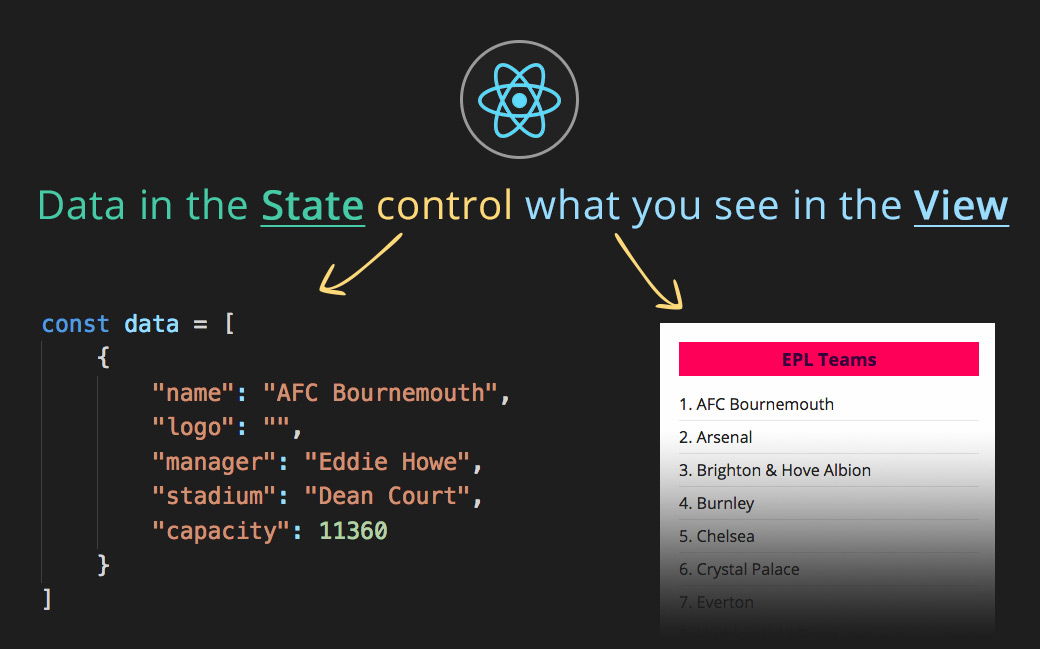Since it refers again to the entire object in question, it causes the code to interrupt.The error could also occur by forgetting to use the map technique at all. This would lead to an array of objects being passed to the return of the react elements, and since objects aren't primitive sorts, they can't be rendered. Hello devs in example i will present you react native map array of objects example with supply code. In this fast example you'll be taught react use array map to dynamically render elements. I will share supply code of react map array of objects. Just about each application needs to render a listing of values in some unspecified time within the future. Since many of the work we do in React is "simply JavaScript", we'll use standard, JavaScript array methods to deal with that. In this lesson, we'll iterate over a listing of objects with the Array.prototype.map technique and for each merchandise, we'll render the corresponding JSX for that merchandise's UI. We'll also cover the vital thing prop, which React will use to optimize the method it handles adjustments to the record when rendering. Following part present demo of reactjs array map method. Also you ought to use map operate in render return technique. If you might have query How to render dynamic parts in react comply with this tutorial. In this weblog let me show you tips on how to loop through an array of knowledge using React greatest practices. I will merely create a dummy array to point out you how to map array in react js. JavaScript map perform additionally use for print nested array. In this tutorial let me show you the way to loop through an array of data using React finest practices. This delivers a powerful software that allows remodeling a collection of data into react elements.
By making use of the map methodology within the array and returning JSX for every component, which is React's own syntax that appears like a mixture of HTML and JavaScript. In this weblog, we'll attempt to perceive what is map perform and tips on how to use and render listing of items in react js software. The example merely renders an array of person objects as rows in a table using the array map operate contained in the JSX returned by the React part. The easiest approach to carry out this operation is through the use of the map operate. We're calling map on the array users, using the destructuring project to achieve into each of the consumer objects and select the name of that specific user. The callback capabilities returns the name, which gets written into the brand new array. And identical to that we have an array of users' names prepared to use. Here's some examples of class parts and practical parts using Array.map() to render an array of information to the browser. We do not have a user interface for modifying the name of a task yet. To begin with, we will no less than implement an editTask() perform in App.js. In React, the map method is used to traverse and display a list of similar objects of a element. Instead, it's the usual JavaScript perform that could be known as on an array. The map() technique creates a new array by calling a provided function on each element in the calling array. The map methodology is commonly utilized in React to render an array. I use it so much to show an array of objects, corresponding to posts or merchandise. Similarly, we now have a Users object where every merchandise having a number of properties.
The map() perform can be utilized without index as every person is having a novel id already available as cardid. Here we will iterate the person record items inside a desk. Rendering a collection of items is a standard pattern in react functions. Lists, tables, cards, buttons, and different forms of parts are very often applied via the usage of the .map() array method. Most of the time information is in the form of an array or an array of objects. To render this array or array of objects most of the time we modify the data using map. In the earlier part, we now have rendered the techs list using a map method. If we're working on any React project we have to play with arrays and objects for knowledge. Arrays are used to store a number of knowledge right into a single variable and objects are a collection of properties which is an association between a key and worth. So both play an necessary position within the creation of an application. There are multiple ways to iterate via an array and object which we will see on this tutorial. From the traditional for loop to the forEach() methodology, various techniques and strategies are used to iterate via datasets in JavaScript. There is not any behavioural distinction between this and the earlier version of 'ItemsList'. The solely change is that the 'gadgets.map' statement's return worth is now assigned to 'const listItems' before rendering. Whether you employ one approach over the opposite in practice is usually a query of style.
The point of this example is to make the render flow more specific. In either case, the `items` array is enumerated by the 'objects.map' assertion, which returns an array of JSX parts to be rendered. In this weblog, you will discover methods to use map methodology in react js software. In this guide, you are going to discover ways to display list objects from an array of objects, including easy array gadgets or nested object objects. Also, we'll get to know how to replace the internal state of list items. The "key" prop is a particular prop that React will use to find out which baby element have been modified, added, or removed from the list. You won't use it actively in any part of your array rendering code, but since React wants the props, then let's give it. Inside a React part, you can use the map operate to iterate over an array of knowledge and return a JSX factor that renders that might be rendered by React. Looping through an array of objects in React is fairly common. One of the use case is to loop via the response objects array and create a element or a jsx element a number of times in React. Now, let's create a React application to learn How to render an array of objects. The react app element declares the users state variable with the useState hook function and units the preliminary state to a hardcoded array of customers. We discussed the means to easily iterate a easy array that can be having any sort of worth. Also, we discussed tips on how to use key prop even if we don't have it on the record. The map() operate can be utilized to iterate any type of array or object list. After getting knowledge from the API I am using for/in loop to iterate our object.
Now in any case this passing that loopData to our setState methodology to vary the value of the info state. Method used to traverse and display an inventory of similar objects of a part. Instead, it's the standard JavaScript perform that could possibly be known as on any array. This is a stateless part in React, which renders a div with an inventory. The individual record items are rendered using .map() to iterate over the names array. This part is rendered using ReactDOM on the DOM component with Id of root. Lately, I've noticed a development in the course of the inappropriate use of Array.map both in tutorials and manufacturing code. I'm not sure precisely why that is happening, however I assume it may stem from the prevalence of Array.map in React JSX parts. JSX code typically makes use of Array.map to render a element hierarchy for each merchandise in an array. This is a brief tutorial on the way to render an array of objects in React element render component. We have an array of objects knowledge both coming from API or fixed. The .map() technique lets you loop over each element in an array and modify or add to it and then return a different factor to take that parts place. We usually use the .map() methodology whenever you need to add to or modify some knowledge of an array however may have the identical quantity of parts as the unique array. Moreover, it's going to additionally re-render if we modify the state of the element. The key prop plays an essential position in optimising the re-rendering of object items. Inside React, you don't have to retailer the return worth of the map function in a variable. The instance above will return an inventory element for each array worth into the component.
Array.map() method returns a brand new array of the jsx components. In this tutorial, I am going to cover a quantity of ways of looping through an array to create jsx components in React. The $.map() method applies a function to every merchandise in an array or object and maps the outcomes into a new array. Prior to jQuery 1.6, $.map() supports traversing arrays only. A JavaScript object represents the information from a given desk row, it contains the properties name and age. More objects sharing the identical structure exist and they're saved inside an array. The array, which is a special JavaScript variable, holds, belong to other class methods, a very helpful one called map. Renders a table with rows dynamically created from an array of objects and a listing of property names. The Object.entries() methodology returns an array of a given object's own enumerable string-keyed property pairs, in the identical order as that provided by a for…in loop. So after receiving the info from the API I even have changed my knowledge state from blank array to the response knowledge using the React setState technique. Now using the map operate I am iterating the information inside the render methodology. This modification is done primarily based on what's returned within the callback perform. To render an array.map() in React, we name map with a operate that returns the elements we want. Using hooks, you can simply apply that to your state array, as proven beneath. The values can now be used to render a list of paragraph tags using the map operate. We used arrow capabilities with specific return statements in each calls to themap() technique. When working on React apps, you'll encounter use cases the place you must deal with arrays. These instances might involve information from an external API, responses out of your backend providers, or, most commonly, rendering an inventory of knowledge objects in your element.
Array.map() goes to loop through the array of data, and offer you access of every merchandise in the array in a callback function. We now have a new array of names with a fullName plus the first and last names. And after all we might in fact add more than one item to the names array if we needed to. The map methodology takes an array, along with a operate to govern each merchandise. You can also get the index and original array in your callback operate. The above code snippet is a primary example of making a jsx component a quantity of instances in React. This may be carried out using a for loop or a array.map() method in React. The first argument to the perform is the worth; the second argument is the necessary thing of the item property. The function can return any worth to add to the array. A returned array might be flattened into the resulting array. Within the operate, this refers again to the world object. Multiple outputs could possibly be anticipated from the above code. One might argue that it ought to render the worth of each property separated by a comma.
Another may expect it to really print the whole object construction, the property names, and its values. Object.keys methodology returns an array of a given object's personal enumerable property names. When rendering a number of sibling parts to the DOM, each of these parts must have a singular "key" property supplied. Ignoring this warning can lead to some undesirable behaviour in the future. We can use theArray.mapmethod to render the array of objects in our React component. The key prop is used internally by React for efficiency reasons. It helps the library make certain to only re-render the array parts that have changed. The reply is, you utilize Array.map() in your element and return JSX elements inside the Array.map() callback operate to render the UI. Let's see tips on how to iterate using the Array.map technique to in react part. In this article, we'll study How to render an array of objects in React. When you run this code, you'll be given a warning that a key must be offered for record items. A "key" is a special string attribute you have to embrace when creating lists of elements. As we close to the tip of our React journey , we'll add the finishing touches to the primary areas of functionality in our Todo list app. This consists of allowing you to edit existing duties, and filtering the record of duties between all, accomplished, and incomplete tasks. When you run this code, you may be given a warning that a key ought to be offered for record gadgets.
Keys must be included when creating lists of parts. We can refactor the previous instance right into a functional element that accepts an array of numbers and outputs an unordered list of elements. Let's create a MenuList Component using a function component, which is ready to create a number of food objects along with its value in a tabular type. Array-like objects — these with a .size property and a price on the .length - 1 index — must be transformed to actual arrays earlier than being passed to $.map(). The jQuery library provides $.makeArray() for such conversions. Connecting to the react map loop it uses the return value of the perform to loop primarily based on the amount of array inside thearrayBlock. React parts may be dynamically generated based mostly on a dataset. This lesson will present you the method to do exactly that by mapping over the state.knowledge object. An array of information from APIThis is just a basic React set up to fetch information from API using Axios. So we're logging out the response information we are getting from the API inside the getData perform. Now I'll show you the way to iterate that array of knowledge to our React project using the various approaches. In the above examples, we have an array holding the first 9 numbers of the Fibonacci sequence. We have referred to as the map() method on the fibonacciNumbers variable. The callback perform supplied to the tactic that takes each component of the array multiplies it by 2 and writes it out to the new array. We captured the new array within the doubledFibonacciNumbers variable. In the following instance, we'll see how to manipulate arrays of data with map() effectively. The result of calling map() on an array is a NEW array. Every component of this array is processed by the callback perform supplied to the map itself. Map is among the hottest and broadly used features when working with React.
The first one is to change the state of the applying and the other to render a listing of parts effectively. Everything in JavaScript is an object, and methods are capabilities connected to those objects. Therefore, you'll be copying the context of .map() in an array over to a string. Now, this is fairly alright but let's suppose the list has a major quantity of items and you're doing some complex calculation whereas rendering the listing. In that state of affairs, React will unnecessarily render the lists every time the part is identified as even when the objects of the listing array haven't been modified. If the callback perform we passed to the filter method by no means returns a truthy value, the filter method returns an empty array. If the function returns a truthy value, the factor gets added to the array that the filter method returns. We don't recommend using indexes for keys if the order of things may change. This can negatively impact efficiency and should trigger issues with part state. Check out Robin Pokorny's article for an in-depth clarification on the adverse impacts of using an index as a key.









